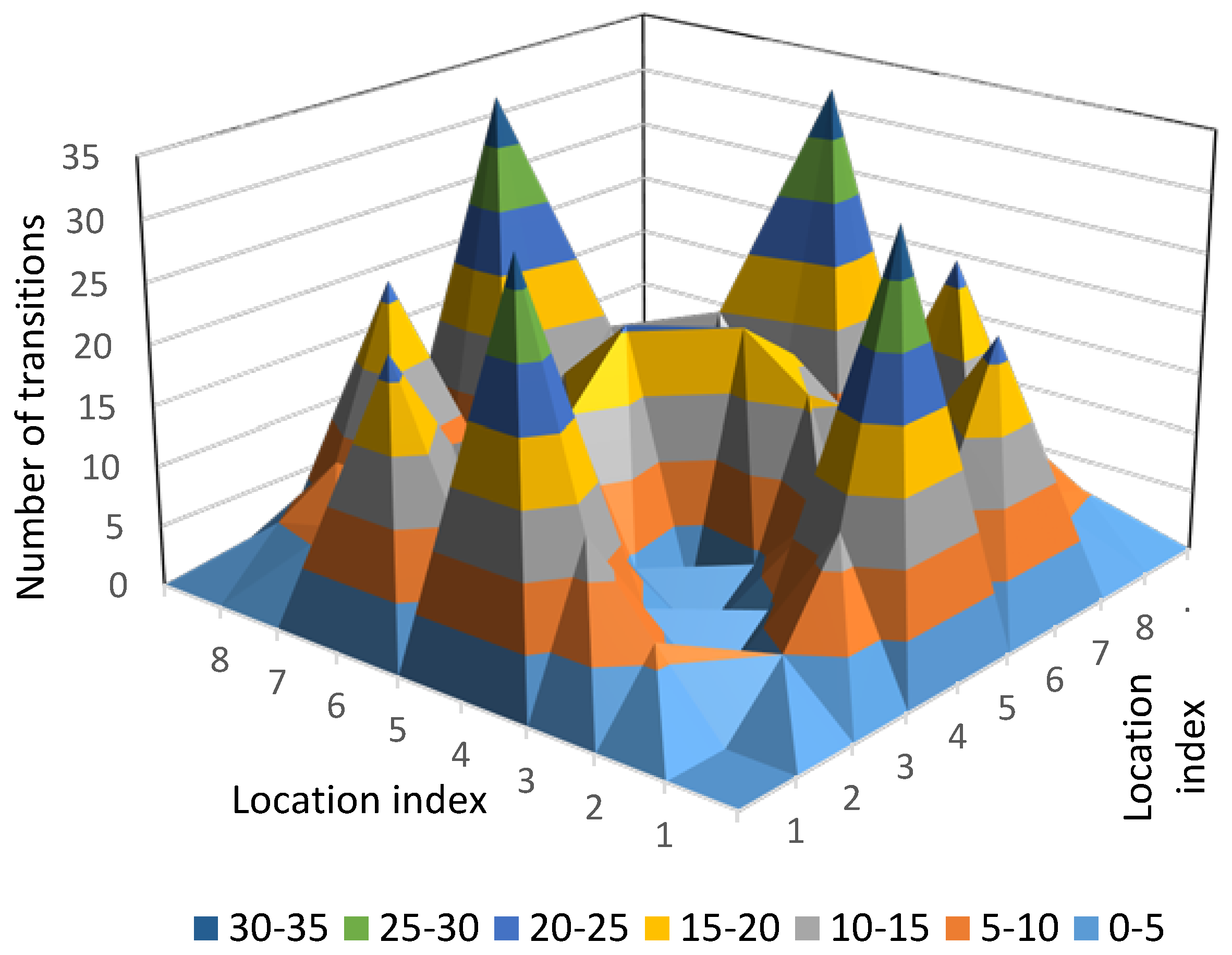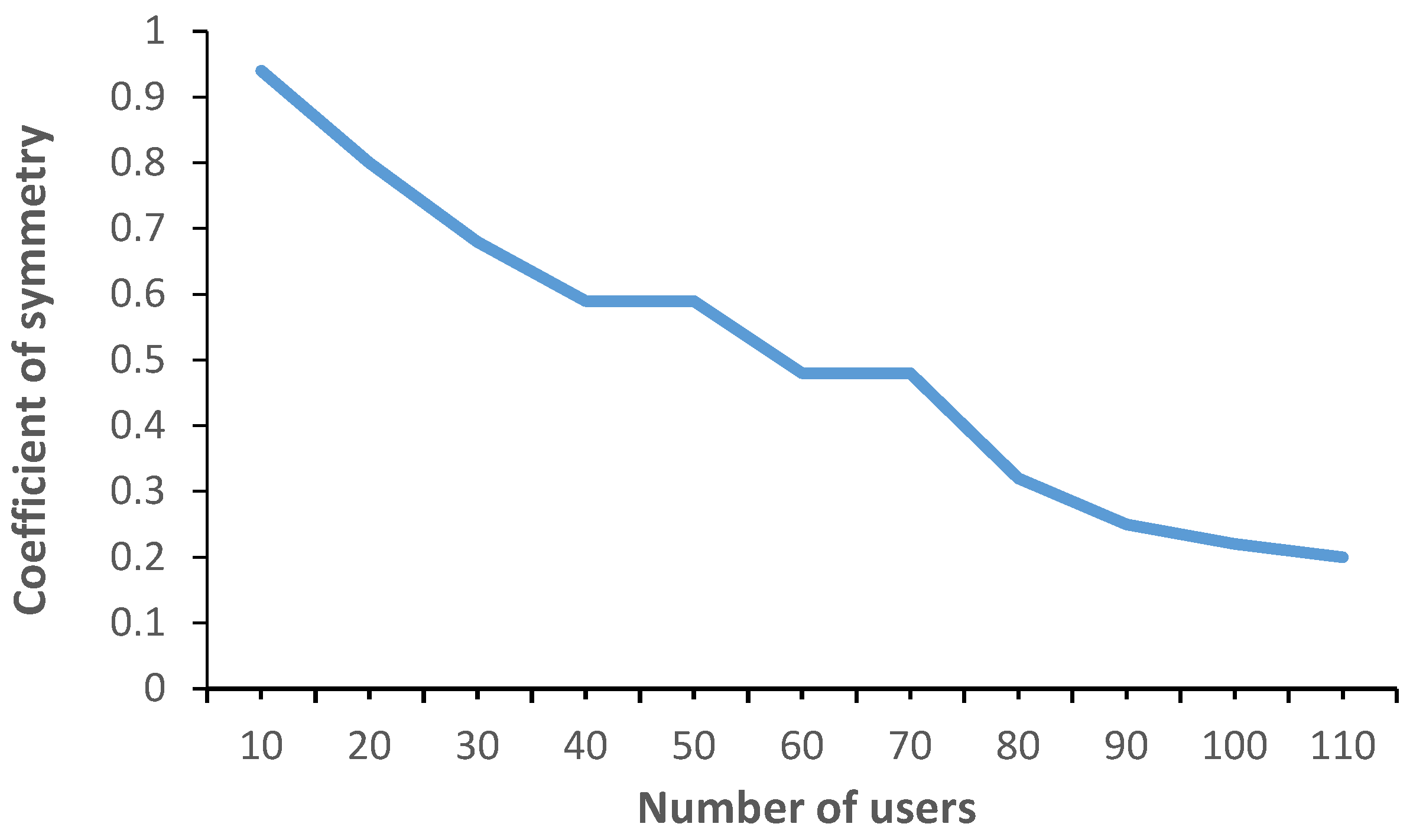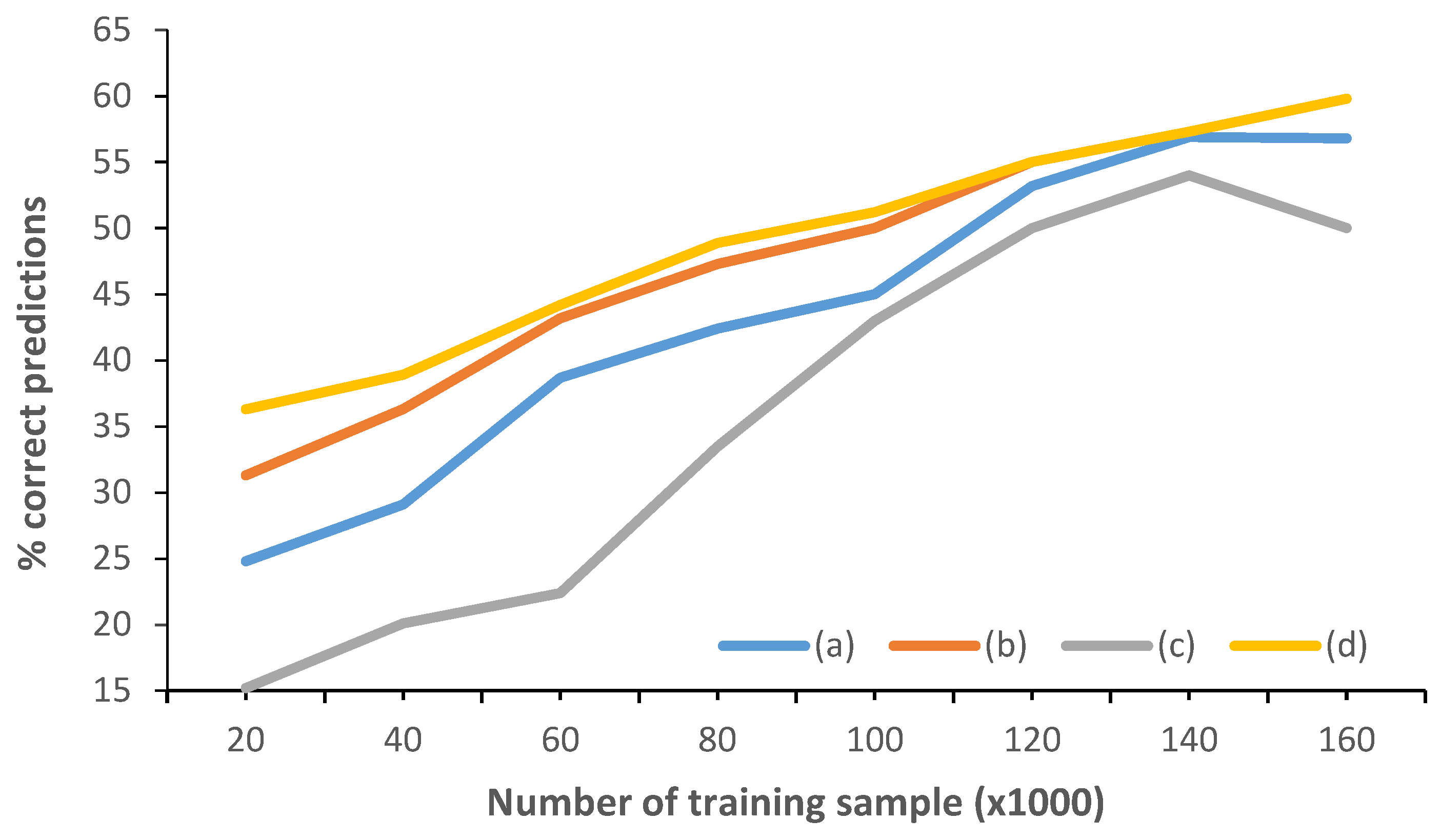Stochastic Cooperative Decision Approach for Studying the Symmetric Behavior of People in Wireless Indoor Location Systems
Abstract
:1. Introduction
- Proximity detection or connectivity-based is one of the simplest positioning methods to implement. It provides symbolic relative location information.
- Triangulation uses the geometric properties of triangles to determine the target location [10]. There are two kinds of techniques: (1) techniques based on the measurement of the propagation-time system and RSS-based and received signal phase methods; and (2) techniques based on the angle of arrival of that the mobile signal is coming from.
- Scene analysis is based on the theory of pattern recognition [11], which combines an electronic map with location information to obtain the real position.
2. Related Work
3. Wireless Indoor Location System
3.1. Wireless Infrastructure
3.2. Node Description
4. Studying the Transition Symmetry
5. Stochastic Approach for Cooperative Location Estimation
5.1. Introduction
5.2. Stochastic Approach
5.3. Inductive Training
6. Experimental Results
6.1. Time Spent in Each Location
6.2. Evaluation of the Location Estimation
7. Conclusions
Acknowledgments
Author Contributions
Conflicts of Interest
References
- Chandra, P.; Dobkin, D.M.; Bensky, D.; Olexa, R.; Lide, D.; Dowla, F. Wireless Networking: Know It All; Newnes Know It All Series; Newnes: Oxford, UK, 2007. [Google Scholar]
- Kaplan, E.D.; Hegarty, C.J. Understanding GPS: Principles and Applications; Artech House Publishers: Norwood, MA, USA, 2006. [Google Scholar]
- Gu, Y.; Lo, A.; Niemegeers, I. A survey of indoor positioning systems for wireless personal networks. IEEE Commun. Surv. Tutor. 2009, 11, 13–32. [Google Scholar] [CrossRef]
- Maghdid, H.S.; Lami, I.A.; Ghafoor, K.Z.; Lloret, J. Seamless Outdoors-Indoors Localization Solutions on Smartphones: Implementation and Challenges. ACM Comput. Surv. 2016, 48. [Google Scholar] [CrossRef]
- Li, F.; Zhao, C.; Ding, G.; Gong, J.; Liu, C.; Zhao, F. A reliable and accurate indoor localization method using phone inertial sensors. In Proceedings of the 2012 ACM Conference on Ubiquitous Computing (UbiComp ‘12), New York, NY, USA, 5–8 September 2012; pp. 421–430. [CrossRef]
- Zheng, Y.; Shen, G.; Li, L.; Zhao, C.; Li, M.; Zhao, F. Travi-Navi: Self-deployable indoor navigation system. In Proceedings of the 20th Annual International Conference on Mobile Computing and Networking (MobiCom ‘14), Maui, HI, USA, 7–11 September 2014; pp. 471–482. [CrossRef]
- Pineda-Briseño, A.; Menchaca-Mendez, R.; Chavez, E.; Guzman, G.; Menchaca-Mendez, R.; Quintero, R.; Torres, M.; Moreno, M.; Diaz-De-Leon, J.L. A Probabilistic Approach to Location Estimation in MANETs. Ad Hoc Sens. Wirel. Netw. 2015, 28, 97–114. [Google Scholar]
- Sendra, S.; Lloret, J.; Turro, C.; Aguiar, J. IEEE 802.11a/b/g/n Short Scale Indoor Wireless Sensor Placement. Int. J. Ad Hoc Ubiquitous Comput. (IJAHUC) 2014, 15, 68–82. [Google Scholar] [CrossRef]
- Farid, Z.; Nordin, R.; Ismail, M. Recent Advances in Wireless Indoor Localization Techniques and System. J. Comput. Netw. Commun. 2013, Article ID 185138. [Google Scholar] [CrossRef]
- Elbes, M.; Al-Fuqaha, A.; Anan, M. A Precise Indoor Localization Approach based on Particle Filter and Dynamic Exclusion Techniques. Netw. Protocols Algorithms 2015, 26, 50–71. [Google Scholar]
- Jain, A.K.; Duin, R.P.W.; Mao, J. Statistical pattern recognition: A review. IEEE Trans. Pattern Anal. Mach. Intell. 2000, 22, 4–37. [Google Scholar] [CrossRef]
- Garcia, M.; Boronat, F.; Tomas, J.; Lloret, J. The Development of Two Systems for Indoor Wireless Sensors Self-location. Ad Hoc Sen. Wirel. Netw. 2009, 8, 235–258. [Google Scholar]
- Fitzek, F.H.; Katz, M.D. Cooperation in Wireless Networks: Principles and Applications. Real Egoistic Behavior Is to Cooperate! Springer: Heidelberg, Germany, 2006. [Google Scholar] [CrossRef]
- Nosratinia, A.; Hunter, T.E.; Hedayat, A. Cooperative communication in wireless networks. IEEE Commun. Mag. 2004, 42, 74–80. [Google Scholar] [CrossRef]
- Mulligan, R.; Ammari, H.M. Coverage in Wireless Sensor Networks: A Survey. Netw. Protocols Algorithms 2010, 2, 27–53. [Google Scholar] [CrossRef]
- Hsiao-Wecksler, E.T.; Polk, J.D.; Rosengren, K.S.; Sosnoff, J.J.; Hong, S. A Review of New Analytic Techniques for Quantifying Symmetry in Locomotion. Symmetry 2010, 2, 1135–1155. [Google Scholar] [CrossRef]
- Nunes, B.A.A.; Obraczka, K. On the symmetry of user mobility in wireless networks. In Proceedings of the 2011 IEEE International Symposium on a World of Wireless, Mobile and Multimedia Networks (WoWMoM), Lucca, Tuscany, Italy, 21 November 2011; pp. 1–6. [CrossRef]
- Deng, Z.; Yu, Y.; Yuan, X.; Wan, N.; Yang, L. Situation and development tendency of indoor positioning. China Commun. 2013, 10, 42–55. [Google Scholar] [CrossRef]
- Lloret, J.; Tomas, J.; Garcia, M.; Canovas, A. A Hybrid Stochastic Approach for Self-Location of Wireless Sensors in Indoor Environments. Sensors 2009, 9, 3695–3712. [Google Scholar] [CrossRef] [PubMed]
- Feng, C.; Au, W.S.A.; Valaee, S.; Tan, Z. Received-Signal-Strength-Based Indoor Positioning Using Compressive Sensing. IEEE Trans. Mob. Comput. 2012, 11, 1983–1993. [Google Scholar] [CrossRef]
- Wang, J.; Hu, A.; Liu, C.; Li, X. A Floor-Map-Aided WiFi/Pseudo-Odometry Integration Algorithm for an Indoor Positioning System. Sensors 2015, 15, 7096–7124. [Google Scholar] [CrossRef] [PubMed]
- Pandya, D.; Jain, R.; Lupu, E. Indoor location estimation using multiple wireless technologies. In Proceedings of the 14th IEEE Proceedings on Personal, Indoor and Mobile Radio Communications, Beijing, China, 7–9 September 2003; pp. 2208–2212. [CrossRef]
- Garcia, M.; Sendra, S.; Lloret, J.; Canovas, A. Saving energy and improving communications using cooperative group-based wireless sensor networks. Telecommun. Syst. 2013, 52, 2489–2502. [Google Scholar] [CrossRef]
- Garcia, M.; Lloret, J. A cooperative group-based sensor network for environmental monitoring. In Cooperative Design, Visualization, and Engineering; Springer Berlin Heidelberg: Luxembourg, Luxembourg, 2009; pp. 276–279. [Google Scholar] [CrossRef]
- Patwari, N.; Ash, J.N.; Kyperountas, S.; Hero, A.O., III; Moses, R.L.; Correal, N.S. Locating the nodes: Cooperative localization in wireless sensor networks. IEEE Signal Proc. Mag. 2005, 22, 54–69. [Google Scholar] [CrossRef]
- Conti, A.; Guerra, M.; Dardari, D.; Decarli, N.; Win, M.Z. Network Experimentation for Cooperative Localization. IEEE J. Sel. Areas Commun. 2012, 30, 467–475. [Google Scholar] [CrossRef]
- Maali, A.; Zeroukhi, L.; Guerfi, A.D.; Baudoin, G.; Mimoun, H. Experimental validation of the cooperative localization algorithm in wireless sensor network. In Proceedings of the European Microwave Conference (EuMC 2013), Nuremberg, Germany, 6–11 October 2013; pp. 334–337.
- Wang, X.; Zhou, H.; Mao, S.; Pandey, S.; Agrawal, P.; Bevly, D.M. Mobility improves LMI-based cooperative indoor localization. In Proceedings of the IEEE Wireless Communications and Networking Conference (WCNC 2015), New Orleans, LA, USA, 9–12 March 2015; pp. 2215–2220. [CrossRef]
- Suijs, J.P.M. Cooperative Decision Making in a Stochastic Environment (No. urn: nbn: nl: ui: 12-76799). Tilburg University, 1998. Available online: http://EconPapers.repec.org/RePEc:tiu:tiutis:a84d779a-d5a9-48e9-bfe7-46dea6f1de69 (accessed on 1 July 2016).
- Krishnan, P.; Krishnakumar, A.S.; Ju, W.H.; Mallows, C.; Gamt, S.N. A system for LEASE: Location estimation assisted by stationary emitters for indoor RF wireless networks. In Proceedings of the Twenty-third Annual Joint Conference of the IEEE Computer and Communications Societies, INFOCOM 2004, Hong Kong, China, 7–10 March 2004; Volume 2, pp. 1001–1011. [CrossRef]
- Wang, H.; Jia, F. A Hybrid Modeling for WLAN Positioning System. In Proceedings of the International Conference on Wireless Communications, Networking and Mobile Computing, 2007 (WiCom 2007), Shanghai, China, 21–25 September 2007; pp. 2152–2155. [CrossRef]
- Roos, T.; Myllymäki, P.; Tirri, H.; Misikangas, P.; Sievänen, J. A probabilistic approach to WLAN user location estimation. Int. J. Wirel. Inf. Netw. 2002, 9, 155–164. [Google Scholar] [CrossRef]
- Xie, H.; Tanin, E.; Kulik, L. Distributed Histograms for Processing Aggregate Data from Moving Objects. In Proceedings of the 2007 International Conference on Mobile Data Management, Mannheim, Germany, 7–11 May 2007; pp. 152–157. [CrossRef]
- Krishnamachari, B.; Iyengar, S. Distributed Bayesian algorithms for fault-tolerant event region detection in wireless sensor networks. IEEE Trans. Comput. 2004, 53, 241–250. [Google Scholar] [CrossRef]
- Nguyen, X.; Jordan, M.; Sinopoli, B. A kernel-based learning approach to ad hoc sensor network localization. ACM Trans. Sens. Netw. 2005, 1, 134–152. [Google Scholar] [CrossRef]







| Parameter | Description | Parameter | Description |
|---|---|---|---|
| l | location | l’ | previous location |
| u | user | h | hour of day |
| d | day of week | t | number of training samples |
| T | set of training data | Ti | training sample i; i ∈ {1,…,t}; Ti = (li, l’i, pi, hi, di) |
© 2016 by the authors; licensee MDPI, Basel, Switzerland. This article is an open access article distributed under the terms and conditions of the Creative Commons Attribution (CC-BY) license (http://creativecommons.org/licenses/by/4.0/).
Share and Cite
Tomás, J.; Garcia-Pineda, M.; Cánovas, A.; Lloret, J. Stochastic Cooperative Decision Approach for Studying the Symmetric Behavior of People in Wireless Indoor Location Systems. Symmetry 2016, 8, 61. https://doi.org/10.3390/sym8070061
Tomás J, Garcia-Pineda M, Cánovas A, Lloret J. Stochastic Cooperative Decision Approach for Studying the Symmetric Behavior of People in Wireless Indoor Location Systems. Symmetry. 2016; 8(7):61. https://doi.org/10.3390/sym8070061
Chicago/Turabian StyleTomás, Jesús, Miguel Garcia-Pineda, Alejandro Cánovas, and Jaime Lloret. 2016. "Stochastic Cooperative Decision Approach for Studying the Symmetric Behavior of People in Wireless Indoor Location Systems" Symmetry 8, no. 7: 61. https://doi.org/10.3390/sym8070061






